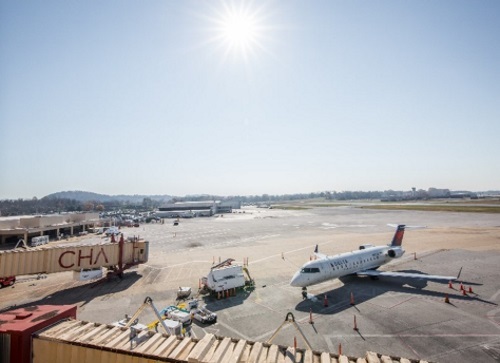The Federal Aviation Administration recently published a final policy aimed at ensuring that airport solar projects do not create hazardous glare for air traffic control personnel and aircraft pilots.
[Above photo by the Chattanooga Airport]
FAA said in a statement that its policy applies to proposed solar energy systems at “federally obligated airports” with control towers – a designation referring to public airports that have accepted federal assistance either in the form of grants or property conveyances.
Under the final policy, airports are no longer required to submit the results of an ocular analysis to FAA. Instead, the airport must file a Notice of Proposed Construction or Alteration Form 7460-1 for FAA review and approval that includes a statement that the project will not cause any visual impact.
The agency said that this final policy supersedes the interim policy it published in 2013.
As more airports invest in solar technology for environmental and economic benefits, the FAA said it wants to ensure the reflection from the systems’ glass surfaces do not create a glare that poses a safety hazard for pilots and air traffic controllers.
For example, the Hawaii Department of Transportation began installing more than 4,260 new “solar modules” two years ago on the 7th floor of the Terminal 1 parking garage – formerly the Interisland Terminal – at Honolulu’s Daniel K. Inouye International Airport; part of its effort to be “100 percent renewable energy reliant” by 2045.
The agency said those solar modules should generate 2 megawatts-DC/1.6 megawatts-AC worth of electricity; enough to power more than 328 homes, based on a full operational day of sunshine, and hopefully reducing the airport’s overall electricity bill by nearly half, Hawaii DOT said.
 Nation
Nation
North Dakota DOT Profiled in State DOT Update
July 3, 2025 Nation
Nation

